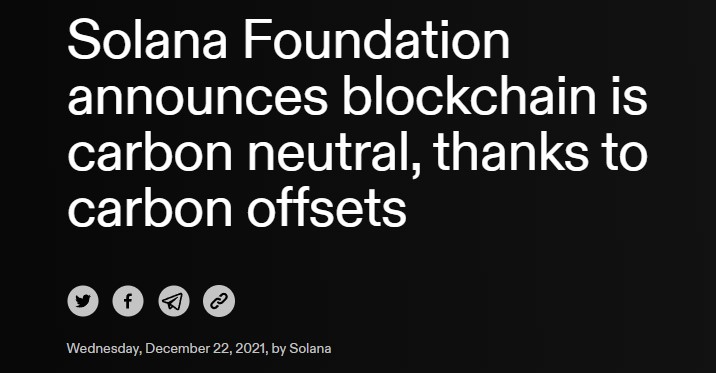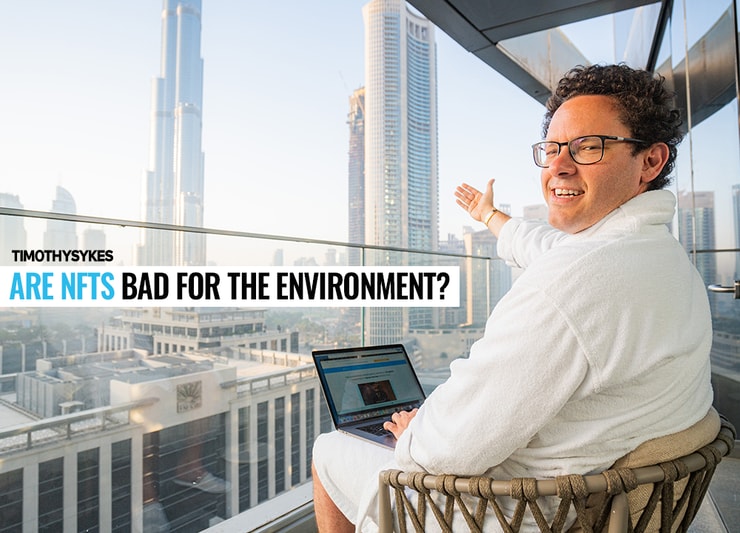You’ve probably heard the big news…
I’m about to release a limited amount of my first NFT collection FREE of charge.
Join me on March 30 at 8:00 pm ET as I interview Adam Jarrett, my student who’s made seven figures from NFTs…
Click here for Adam’s three-step system and news that will change the future of NFTs.
My email and DMs are blowing up.
One question keeps coming up…
“Tim, are NFTs bad for the environment?”
It’s no surprise given my background with Karmagawa…
After all, we produced “50 Minutes to Save the World.” In less than three years, the documentary has over 15 million views.
So some people were confused when I announced my NFT project. I’m glad people are asking about NFTs and the environment.
Why?
Because it’s a subject very near and dear to my heart…
Table of Contents
The Dark Side of Digital Art
Like crypto, NFTs are traded using blockchain technology. I used to rip on both crypto and NFTs all the time.
I’m launching my own NFT collection Wednesday night, March 30 at 8pm EST, tune in FOR FREE at https://t.co/MS18z8hIbu for all the details as while I’ve ripped on crypto/NFTs in the past due to all the scammers (block and report all fakes!), there’s too much opportunity to ignore! pic.twitter.com/v7CQ2PCsXb
— Timothy Sykes (@timothysykes) March 28, 2022
One thing I’ve never liked about crypto is all the scammers. Not to mention it brought so many criminals together under one currency. But another reason was its environmental impact.
Early cryptos like bitcoin and ethereum use on-purpose inefficiency for security. The problem is, it uses a ton of energy…
Crypto Relies on Fossil Fuels
And that doesn’t sit well with me.
By some estimates, bitcoin uses as much energy as a European country.
Ethereum isn’t much better. The on-purpose inefficiency is creating a huge carbon footprint.
To be fair, ethereum claims its energy usage will drop 99.5% when it shifts to a new blueprint. Sadly, they’ve been saying it for years.
As a matter of fact, it’s so bad that the World Wide Fund for Nature (formerly the World Wildlife Fund) halted the sale of its NFT collection. In the balance, it didn’t make sense to them as protectors of the environment.
The thing is…
Some Blockchains Are NOT Energy Intensive

This is important, so pay attention. There are two kinds of blockchain…
Proof of Work
In a proof-of-work (PoW) blockchain, members use computing power to solve an arbitrary puzzle. PoW benefits from security — it’s more difficult to game the system.
It also uses increasing amounts of energy. Why? Because users are competing against each other to solve the puzzle. There could be hundreds of computers working on one puzzle but only one solves it. All the energy used by the other computers is wasted.
More Breaking News
- Is Grayscale Bitcoin Trust’s Recent Increase a Buying Signal or a Fade?
- Quantum Computing Stocks: Navigating the Highs and Lows
- Innoviz Technologies’ Stock on a Roll: What Factors are Driving the Surge?
Proof of Stake
In a proof-of-stake (PoS) blockchain, transaction validators have to own a certain number of tokens. In other words, you have to have skin in the game to be a validator. The validator for any given transaction is chosen at random from all those with proof of stake.
Some hardcore De-Fi nerds consider it less secure, but the reduction in energy is huge.
So the answer to the question is a little complicated…
Creating the NFT Is Not Energy Intensive

At least not in the same way as mining or validating the transaction.
French artist Joanie Lemercier even looked into using NFTs as a way to reduce his carbon footprint. Here’s what he found…

NFTs are hot, but so is their effect on the Earth’s climate. What looks like a lower environmental impact is a disaster waiting to happen.
So, he famously canceled his second NFT drop and became an activist for only using low-energy PoS platforms.
Related aside…
Even on a PoW blockchain, only high-value/highly-traded NFTs use a lot of energy. Makes sense, right? If nobody wants it, there’s no transaction. That means no work (energy spent) solving the transaction puzzle.
So, now you know that PoS blockchains make more sense. The next question is … “Tim, which blockchain do you like?”
The Case for Solana

Like I said, I’ve done hours and hours of research to prepare for this project. Again and again, one blockchain solution kept coming up.
It’s not the only PoS blockchain but it’s super-fast, very low cost, and…
Solana Is Carbon Neutral

Solana achieved carbon neutrality in 2021. How?
To start, it’s one of the most energy-efficient blockchains. A single Solana transaction uses 1,939 Joules. That’s about as much energy as doing two Google searches.
Compare that to Bitcoin which uses 7,412,400,000 Joules per transaction. Exactly how much energy is that?
Check this out…

According to data from the Cambridge Bitcoin Electricity Consumption Index, one year of bitcoin mining could boil enough water for Brits to drink 30 years’ worth of tea!
What about Ethereum? It’s lower than Bitcoin but still uses 777,600,000 Joules.
Solana is more efficient than either bitcoin or ethereum — by a longshot. But energy efficiency doesn’t mean carbon neutral. So what is Solana doing to offset its small carbon footprint?
The Solana Foundation is funding refrigerant destruction. That means permanent destruction of CFC and HFC refrigerants. Those two greenhouse gasses are 10,000 times as potent as CO2.
So for me, Solana is the way to go.
Are NFTs bad for the environment? It depends on the blockchain.
Rest assured…
When you join me for the NFT Trading Summit on Wednesday, March 30 at 8:00 pm ET…
I’ll show you how to learn all you need to know about the coming NFT explosion.
At the same time, I’m doing everything possible to be a good steward of the environment.
Now you have two choices…
You could walk away and miss the big event. If you do that, you’ll be missing the opportunity to get in on what could be one of the biggest market rushes of all time.
Or…
You can learn about Adam’s rollercoaster trading journey…
… from penny stocks to crypto and NFTs.
More importantly…
Adam is going to share his breakthrough three-step system he uses to make millions in NFTs and…
… the catalyst that will change the future of NFTs.
This market is growing at warp speed.
Click below to register for the big event on Wednesday, March 30 at 8:00 pm ET…
NFT Trading Summit — How a 25-Year-Old Trader Made Over $1 Million In 10 Hours From NFTs
What do you think of Solana and its low environmental impact? Comment below, I love to hear from all my readers!


Leave a reply